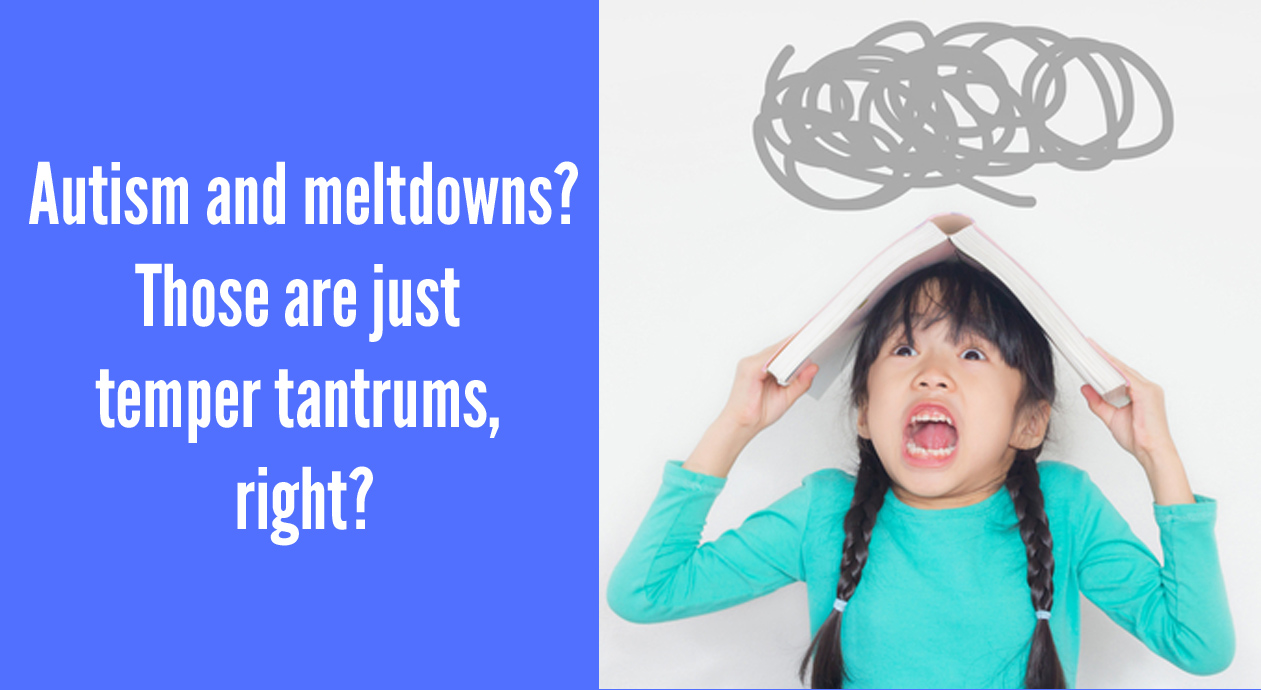Wrong… and treating them the same will make matters worse.
That’s because tantrums and meltdowns come from very different places.
- A child can control a tantrum. Tantrums are usually sparked by a disagreement with authority. For instance, the pupil wants to stop working, the adult tells them ‘no’, and the pupil explodes. During a tantrum, a student will often pause to see if the adult is watching them.
- A meltdown occurs when a student is no longer able to cope. It is caused by anxiety and overwhelm. In a meltdown, the child isn’t in control of their emotions.
Meltdowns are mostly associated with conditions like autism and sensory processing disorder. (I’m often asked the difference between autism and ADHD – if you’re not sure, check out this article).
The key thing to remember is: meltdowns are fuelled by anxiety.
We all have a limited capacity to cope with anxiety and stress. It’s a bit like a balloon. Every time you blow into the balloon, the pressure inside increases. Add enough pressure and the balloon explodes.
It’s the same with meltdowns.
When a student perceives a threat in the classroom, their anxiety levels increase. The meltdown arrives when the student can no longer manage those strong emotions. They become overwhelmed and then meltdown.
At this point, adding extra pressure on the student makes things worse.
So, our aim should be the complete opposite: to reduce the pressure on the student as much as possible. To let some air out of the balloon.
Or – ideally – to manage the child’s exposure to those pressures in the first place, so they never get stressed.
The formula is: LESS ANXIETY = FEWER MELTDOWNS.
But how do you do it?
Here are 3 common causes of classroom anxiety – and how to avoid them.
Sensory overwhelm
Students with ASD can be over-sensitive or under-sensitive to certain senses.
For instance, they may find:
- classroom noises and chatter painful to the ears, (as though the volume’s turned up to 11)
- the sensation of sitting in chairs or wearing clothing uncomfortable and stressful
- classroom lights painful to the eyes
These sensory differences lead to significant increases in anxiety.
The solution is to help manage the sensory load for the student.
For example:
- wearing ear defenders during noisier parts of a lesson
- using sensory cushions on chairs
- working at a table surrounded by a screen
Every student’s sensory sensitivities will be different. Observe those differences, and where possible, find a compensating strategy for it.
Transition overwhelm
Many students with autism find transition stressful – even upsetting.
I’m using transition here in the wider sense. So that could mean any change. Such as:
- moving from one room to the next or…
- from one activity to the next
In the words of the National Autistic Society:
“Consistent, predictable routines and structure are very important for autistic people and a change to routine can be very distressing.”
How can we support students with ASD cope with transition? Here are some strategies proven to work in the classroom:
- Visual timetables or Now and Next boards
- Timers and hour glasses
- Verbal reminders from adults (eg. “this activity will end in 5 minutes before we start our French lesson”)
- In / out trays
As with all students, the key is to find a strategy that works for them – and use it consistently.
Social overwhelm
Many people with ASD find being in social environments stressful.
- Students with autism often experience communication difficulties. Receptive difficulties affect your ability to understand what other people have said. Expressive difficulties impact your ability to communicate your own thoughts and emotions.
- Some students also find it difficult to ‘read’ people. They misinterpret the comments and intentions of their classmates, leading to arguments.
- Students with autism may also find it hard to learn social routines that others take for granted. This leads to sensations of anxiety, frustration and isolation.
These factors can all lead to high levels of anxiety in social situations.
And with the best of intentions, many adults push children with ASD into social groups, because they don’t want them to be excluded.
This can have unintended consequences. The longer the student remains in the group, the more anxiety is piled on.
The solution?
Manage how long your student spends in a social group. This gives them recovery breaks, relieving pressure and anxieties.
To use the example of a balloon filled with air:
- the student works with a partner (increases pressure in balloon)
- then spends some time working by themselves (reduces pressure)
- then works in a group of 6 (increases pressure)
- then works by themselves again (removes pressure again)
Another great way of avoiding overwhelm is to use social stories. Social stories explain to children with autism what to expect in social situations and how to behave.
There's a detailed guide to creating and telling social stories on Autism Parenting Magazine's website.
Conclusion
Meltdowns and tantrums may look similar – but they have very different causes. And handling a meltdown requires an entirely different approach.
Aim to reduce pressure from sensory, transition and social overload where possible. This will lower the student’s anxieties – reducing the chance of meltdowns.
And, of course, every student is different. So find out:
- what causes that particular student anxiety…
- and what practical strategies you can use to manage them

